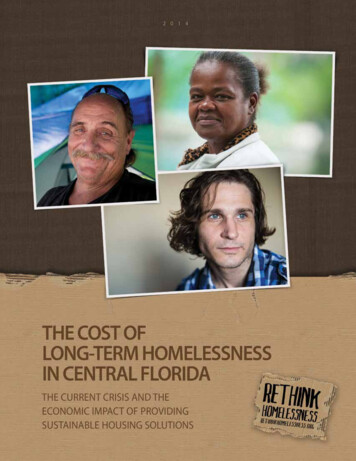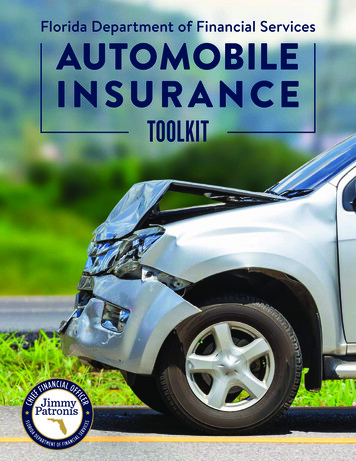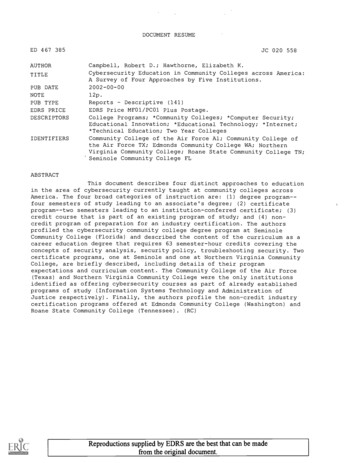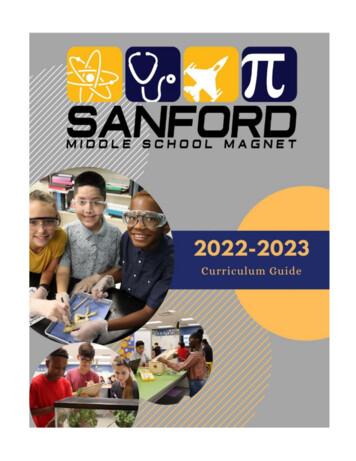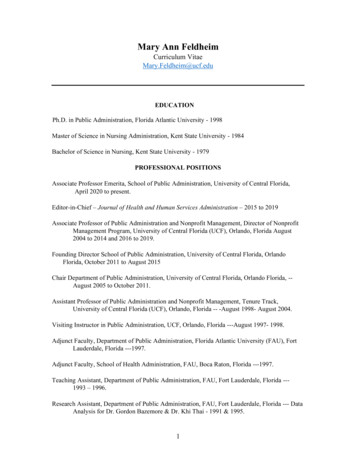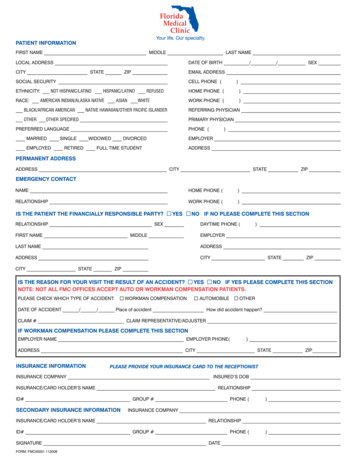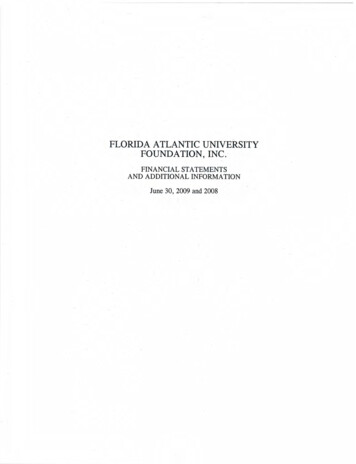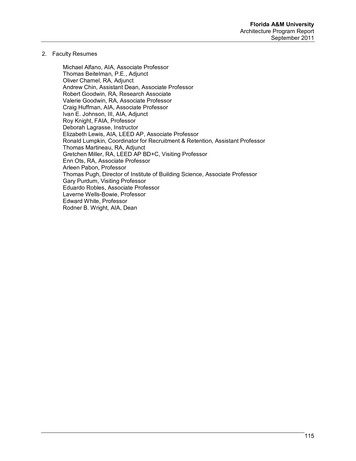
Transcription
Part FourFlorida’s Seminole PeoplefFloridaseminolePeoplewww.flmnh.ufl.edu 2002 Florida Museum of Natural History, Gainesville, Florida61
Florida’s seminole PeoplePlease be sure to read Part One before going through this section. It contains informationnecessary to use this and other Inquiry Boxes and to visit the Museum.fFloridaseminolePeople62To see individual items in the Florida’s Seminole People Inquiry Box, visit the Museum’s website atwww.flmnh.ufl.edu. 2002 Florida Museum of Natural History, Gainesville, Floridawww.flmnh.ufl.edu
Florida’s seminole PeopleFrequently Asked Questions about Florida’s Seminole PeopleWho are they and where did theycome from?The Seminoles are Native American people who still live inFlorida today.The Seminoles are a mixture of native people and refugeeswho came to Florida from the lower southeastern part ofAmerica. By the early 1700s, the early native populations inFlorida were greatly reduced in number because of disease,warfare, and slavery. Florida was largely uninhabited.Native people in the lower southeast were also under greatpressure from the Europeans. With encouragement fromthe local Spanish government, southeastern native peoplebegan migrating to Florida. Other refugees, includingAfrican Americans, also migrated to Florida.These early immigrants were called “cimarrones,” whichmeant wild or untamed in Spanish. The name then became“Simanoli,” which connoted emigrant or frontiersmanamong the Indian people. It was eventually accepted as“Seminole” and referred to all Indian people in Florida. Thename has also been translated as runaway, renegade,pioneer, adventurer, separatist, and freeman.The name Seminole first appeared in documents in the1760s. This reflected the continuing migration of the nativeCreek people into Florida from the early 1700s.Between 1817 and 1858 there were three wars betweenthe Seminole people and the U.S. government. TheSeminole never conceded defeat in any of the wars.However, more than 3,000 Seminole people were capturedand deported to Oklahoma. A few hundred evaded captureand survived in the remote areas of southern Florida’sEverglades. These are the ancestors of today’s FloridaSeminole and Miccosukee people.www.flmnh.ufl.eduToday the name refers to one group of NativeAmericans in Oklahoma and three groups in Florida.Only one group in Florida is officially “The SeminoleTribe of Florida.” Another group in Florida is officiallythe “Miccosukee Tribe of Indians of Florida.” It is aculturally similar group that chose not to apply forfederal status with the Seminole Tribe of Florida in1957. However, it later received federal recognition asthe Miccosukee Tribe. The last group is a smallindependent group that has not sought federalrecognition. They are culturally related to the Seminolesand Miccosukees.Where do the Seminoles live today?Most members of Florida’s Seminole tribe live on sixreservations. There are approximately 2,500 members.The reservations are located around South Florida:Hollywood (where the tribal headquarters is), BigCypress, Brighton, Immokalee, Tampa, and Ft. Pierce(the newest reservation). Seminoles also live elsewherein Florida and across the nation. Large numbers live inOklahoma. They are the descendants of those forcedwest by the U.S. government.What kind of houses do they live in?Today most Seminoles live in houses likeother Americans.A few Seminoles still live in the traditional chickee.A chickee is an open-sided house made of cypresspoles with a palm-thatch roof. It is the house that earlySeminoles lived in for many years in isolatedhammocks.fFloridaseminolePeople 2002 Florida Museum of Natural History, Gainesville, Florida63
Florida’s seminole PeopleWhat did they eat?How did they travel?Early Seminole people depended on hunting andfishing like other Florida Indian people.Seminoles used dugout canoes as theirprimary means of transportation because ofthe extensive waterways that existed in the Everglades.As always, people walked, and horses were usefulwhen available.They grew gardens of corn, beans, squash, Indianpotato, and a type of pea. They also gathered wildplants like coontie, the root of which was used tomake flour.The Seminole also raised livestock like cattle and hogs.Today they eat the same kinds of food that everyoneelse does. But they also enjoy some traditional foods.Today Seminoles use mostly cars and trucks.How do we know about these people andtheir environment?Our knowledge of early Seminoles comes primarilyfrom the records of the Spanish, British, and Americans.What kind of clothing did they wear?fFloridaEarly Seminoles wore the traditional clothing ofsoutheastern native people. As they moved south,their clothing was adapted to the warmer, morehumid climate. They also adopted some elementsof European clothing.In the 1880s, sewing machines became available to theSeminoles. The women started to sew with themachines instead of sewing by hand. By the 1920s, theold appliqués became patchwork that was sewn intothe cloth rather than on top of it.Accounts also come from visitors like William Bartramand from archaeological evidence found at sites likePayne’s Town, Cuscowilla, Ft. King, Ft. Brooke, Powell’sTown, Oven Hill, and Talahasochte.Today, Seminoles share their culture through manydifferent avenues. They have a website atwww.seminoletribe.com, publish a newspaper calledthe Seminole Tribune, and also have two museumslocated at the headquarters in Hollywood and on theBig Cypress reservation.seminolePeople64 2002 Florida Museum of Natural History, Gainesville, Floridawww.flmnh.ufl.edu
Florida’s seminole PeopleINQUIRY BOX CHECKLIST8 1/2 x 11 Laminated CardsPicture contents cardsMap of southeastern United StatesWoman sewingCattle herdBall stick gameWoman with mortar and pestleCoontie plantArtifactsSweetgrass basketSeminole dollBranding ironSofkee spoonWooden canoeBall stickMortarPestleSeed jarEar of cornSmilax rootFlagChildren’s vest and/or skirt and patchwork sampleNewspaperBooks and VideoLegends of the Seminoles (Jumper)Seminoles: Days of Long Ago (Mulder)Native Americans in Florida (Wickman)Seminole Colors (Seminole Indian Artists)Seminole (30 minutes)Word CardschickeecimarronesLa isofkeeGamewww.flmnh.ufl.edu30 bean bags30 laminated word cardsLaminated directions card 2002 Florida Museum of Natural History, Gainesville, FloridafFloridaseminolePeople65
Florida’s seminole PeopleINQUIRY BOX CONTENT DESCRIPTIONSLaminated Southeastern United States MapTrace the history of the Seminole people toFlorida, note reservation locations, and/or pinpointfamiliar landmarks.Ear of Corn; Jar of Beans and Squash andPumpkin SeedsfFloridaseminolePeople66These represent basic Seminole crops. Corn is the mostimportant. Crops were grown again after theSeminoles’ lives became more settled. During the waryears and the first years in the Everglades, farming wasnot practical. These were lean years, and the Seminolesrelied more on wild food. See also sofkee spoon,mortar and pestle, and picture of woman with mortarand pestle.Coontie PlantCoontie (from the Mikasuki word konti) is a tropicalcycad of the scientific genus Zamia. Both Seminolesand earlier Florida people ate the root after processing.Coontie had to be washed, boiled, and fermentedbefore it was safe to eat. It was prepared by grinding itinto flour for use as a staple carbohydrate. If you wantto view a whole plant, see the FLMNH’s ancient plantgarden outside the front entrance.used for grinding large quantitiesof corn. Smaller ones were used forsmall quantities and other food items.The pestle is held with the heavy end up forincreased leverage. Folklore says that only a familywith multiple daughters could have a large mortarand pestle.Laminated Picture of Woman with Mortar and PestleNote the relative size of the picture’s contents and thatthe heavy end of the pestle is up. Also note thewoman’s dress, necklace, hairstyle, and chickee.Branding IronSeminole cowboys would have used this piece ofequipment in their cattle ranching. The original cattlewere inherited from abandoned Spanish ranches on theLa Chua prairie. The Seminole people probably stoppedraising cattle during the Seminole wars. In the 1920sthe federal government shipped drought-starvedwestern cattle to Florida. This gave the Seminoleanother opportunity to start cattle enterprises.Laminated Picture of Cowboys Working Cattle at PensThis picture depicts a modern Seminolecattle operation.Chickee (chikíe, pronounced chi-gét in Mikasuki)Sofkee SpoonOur sofkee spoon is a miniature replica of a woodenladle that always accompanied an ever-ready pot ofthin corn soup (sofkee). The spoon’s shape issomewhat unique. There is a slight bend halfway upthe handle. In full size, it would be about 18” long.Ours was made by a Seminole woodcarver. One recipefor sofkee says to add 1 cup of grits to 6 cups of waterand cook until milky in color.Mortar and PestleThis miniature replica represents a large mortar andpestle like the one shown in the picture of the womanwith the mortar and pestle near the chickee. Theoriginal tools were made from oak. Large ones were 2002 Florida Museum of Natural History, Gainesville, FloridaChickees come in two styles. One has a raised woodenfloor and was used for sleeping, storage of goods, andsometimes eating. The floor raises the inhabitants andgoods above the soggy ground. It allows air to circulateabove and below the floor and keeps some animalsout. The lower roof sides provide protection against theweather, but still allow good air circulation. The otherstyle of chickee has no floor. The roof is only acovering from weather to protect fires, cooks, andkitchen goods. Both styles were made from cypresslogs and palmetto fronds. In the laminated pictures,note the chickee in back of the woman with the mortarand pestle and the chickee over the woman who ismaking patchwork using an old sewing machine.www.flmnh.ufl.edu
Florida’s seminole PeopleDugout CanoeThe canoe was “as important to[Seminole] life as the horse would laterbecome to the Plains Indians,” according to Patricia R.Wickman in Seminole Colors, particularly after theSeminole moved into the Everglades. A full-sized canoewould have been made from a cypress log. Cypress wasplentiful in swamps. Because the tree grew in water, it didnot rot easily and could be “sunk” when necessary. Theboat was built in two sizes: one size for carrying a singleperson and another size for carrying an entire householdand its contents. The canoe was propelled with a pole. Thelarger canoe may have been fitted with a sail in addition tothe pole. The main purpose of the canoe wastransportation since the Seminoles were not a major fishingculture. Some of the Inquiry Box miniature canoes weremade by one of the Seminole’s last traditional canoemakers, Henry John Billie.Ball StickThe traditional ball game was played in some version bymany southeastern tribes. Hitting a tall, slim pole with ahard tennis ball-sized sphere that is thrown with a smalltennis racket-like stick scores points. The game is played onmany occasions, including the Seminole’s Green CornDance. Rules vary with location and occasion.Laminated Picture of Ball GameNote the dress of men and women. The women have nosticks and have bare feet. Can you tell from this picturewhether those are traditional factors in the game?Legends of the Seminoles, by Betty Mae JumperThere are two Seminole languages, and both are based inthe oral tradition. Jumper is a former tribal chairwomanwho has gathered and had illustrated some of the storiesthat she remembers. She says that stories were usually toldby grandmothers at night around a fire to teach children.“The Corn Lady” is long, but it has been successfully usedwith fourth grade classes. Shorter stories, suitable forreading aloud, are noted inside the front cover of the book.www.flmnh.ufl.eduChild’s Patchwork Vest and/or SkirtConnie Gowens and Linda Jim Seminole Indian BirdClan made many of the Seminole clothing items. Red,white, black, and yellow are considered powerfulcolors. Shirts, jackets, and skirts are common Seminolemade garments. Patchworks are distinctive bands ofdesigns that are made of colorful strips of cloth. Largestrips are cut into smaller strips and sewn together intoa pattern. Patchwork became possible when handdriven sewing machines became available in the late1800s. Better machines were introduced in the 1920s.Earlier Seminole garments were just bands of colorfulcloth without a pattern or design.Laminated Picture of Woman with Sewing MachineIn addition to the old sewing machine, note thewoman’s dress with cape, her necklaces, and the polesof the chickee above her. The cape was probably anadaptation of an earlier ruffled garment: a long-sleevedblouse. A lightweight cape over a sleeveless blousewould have been cooler in the warm climate of SouthFlorida. However, it still offered protection against thesun and insects.Palmetto DollThe body of the doll is made from palmetto fibers. Sheis dressed in the traditional Seminole style: her dresshas bands of cloth and not patchwork; she wearsnecklaces; her hair is arranged in the old style. A younggirl was given her first necklace by the age of 12 andreceived another one each year. As a mature woman,she began removing one a year. The doll’s hairdo is nota hat. It is hair arranged over a frame to appear like awide- brim hat. This creative hair design resembles ahat, but is distinctly Seminole.Sweetgrass BasketOther materials have been used by the Seminoles tomake baskets, but the decorated sweetgrass basket isnow the most common. These baskets are usuallymade for the tourist trade. It is becoming harder to findsweetgrass in South Florida. It is harvested only duringcertain times of the year and in limited locations. 2002 Florida Museum of Natural History, Gainesville, FloridafFloridaseminolePeople67
Florida’s seminole PeopleSeminole FlagThe Seminole TribuneThe Seminole Tribe of Florida currently uses this flageven though the Tribe has not officially adopted it.The four traditional colors represent the four pointsof the compass. East is yellow. North is red. West isblack. South is white. The central seal represents thetribal council that leads the Tribe and includes a fireand a chickee.“The Voice of the Unconquered”reports current and historical news ofinterest to members and friends of the Seminoleculture. “The Unconquered” refers to the fact thatnone of the three wars fought between the U.S. andthe Seminole resulted in a formal surrender.Miccosukee FlagfIt is shown on the reverse of the Seminole Flag.The Miccosukee Tribe of Indians of Florida adoptedthis flag in 1962. According to Miccosukee belief, lifespins in a circle starting in the east and moving to thenorth, to the west, and to the south. The colors thatrepresent those directions are the same as those in theSeminole flag.FloridaseminoleKEY e68 2002 Florida Museum of Natural History, Gainesville, Floridawww.flmnh.ufl.edu
Florida’s seminole PeoplefFloridaseminoleThis map of the southeastern United States shows1) some common landmarks,2) the most recent Seminole ancestors (the Creeks) andtheir approximate locations, and3) small letters designating the current SeminolereservationsT TampaI ImmokaleeB BrightonH HollywoodFP Ft. PierceBC Big Cypress4) and the Miccosukee (Mic) reservationwww.flmnh.ufl.eduPeople 2002 Florida Museum of Natural History, Gainesville, Florida69
Florida’s seminole PeoplePhotos of traditional Seminole clothingfFloridaseminolePeople70 2002 Florida Museum of Natural History, Gainesville, Floridawww.flmnh.ufl.edu
Florida’s seminole PeopleINQUIRY BOX CLASSROOM ACTIVITIESTeachers may have students engage in thefollowing activities.1. Visit the Seminole Tribe’s website:www.seminoletribe.com. Report to your class whatyou found there.Version One2. Visit the Ah-Tah-Thi-Ki Museum on the BigCypress reservation in person or online. What doesthe museum’s name mean? 3. Write a paragraph about one way that life changedfor the Seminoles after they moved from Georgiaand Alabama to southern Florida. 4. Using a map of Florida, find three of the sixSeminole reservations. What towns are they near?Explain the route you would take to get to theclosest one. Mark the pole about 10 feet from the top withmasking tape.Players need to stand back 5 feet from the pole.Each player has 5 turns to throw the ball atthe pole.If the ball hits the very top of the pole, the playergets 4 points.If the ball hits above the tape, the player gets2 points.If the ball hits below the tape, the player gets0 points.A referee may be needed to judge exactball locations.Version Two5. Write a story that explains why you think thesofkee spoon has a bend in it, or why the raccoonlooks like he is wearing a mask.6. Seminoles enjoy the traditional ball game commonto southeastern native people. There weredifferences in the game between each tribe.Sometimes two towns would challenge each other.Play was so vigorous that players would be hurt, oreven killed. Today’s version of the ball gameinvolves only one pole and play is not so fierce.Both men and women can play. With the rightequipment, you can play also. Version Three Equipment A pole that is 25-30 feet highMasking tapeA tennis ballPaper and pencil to keep scorewww.flmnh.ufl.eduDivide the players into 2 teams. Proceed as above.The team with the most points wins.Players can score only by hitting the top ofthe pole.Players are divided into two teams.The ball is a hard tennis ball.The players need a throwing stick. It should have arounded, woven basket at one end for throwingthe ball.Players use one or two sticks and throw the ball atthe top of the pole from anywhere on the field.The first team to reach a pre-set number ofpoints wins. 2002 Florida Museum of Natural History, Gainesville, FloridafFloridaseminolePeople71
Florida’s seminole PeopleInquiry Box Seminole Game – words and instructions1. The object of the game is to cover (with a bean)five words in a row down, across, or diagonally. Iftime allows, you might ask for ALL words to becovered. Students should say "Seminole" whenthey have reached the announced goal.2. The leader may simply call out these words, or,where possible, show the objects in the InquiryBox. If you are showing the objects only, note thata) either "canoe" or "dugout" (or both) wouldsatisfy for that object, and b) squash, pumpkin,and beans are all noted in the seed panishmortar & pkincampclanswampFloridaCreekbranding irondollchickeeball sticklegendThis game could be used as an ongoing activity as youtalk about objects, or as a review activity, or with aclass that needs a group interactive.There are 30 game cards and 30 bean bags (25beans each) per Inquiry Box. Please try to return allbeans and bags to the Inquiry Box after use.People72 2002 Florida Museum of Natural History, Gainesville, Floridawww.flmnh.ufl.edu
Florida’s seminole PeopleSamples of the laminated playingcards which may be found in theInquiry Box.fFloridaseminolePeoplewww.flmnh.ufl.edu 2002 Florida Museum of Natural History, Gainesville, Florida73
Florida’s seminole PeoplePhotos of modern chickee constructionfFloridaseminolePeople74 2002 Florida Museum of Natural History, Gainesville, Floridawww.flmnh.ufl.edu
Florida’s seminole PeoplefFloridaseminolePeoplewww.flmnh.ufl.edu 2002 Florida Museum of Natural History, Gainesville, Florida75
Florida’s seminole PeopleActivity One – Word PuzzlefFloridaseminolePeople76 2002 Florida Museum of Natural History, Gainesville, Floridawww.flmnh.ufl.edu
Florida’s seminole PeopleActivity Two – Word PuzzlefFloridaseminolePeoplewww.flmnh.ufl.edu 2002 Florida Museum of Natural History, Gainesville, Florida77
Florida’s seminole PeopleActivity three – crossWord PuzzlefFloridaseminolePeople78 2002 Florida Museum of Natural History, Gainesville, Floridawww.flmnh.ufl.edu
Florida’s seminole PeopleActivity Four – crossWord PuzzlefFloridaseminolePeoplewww.flmnh.ufl.edu 2002 Florida Museum of Natural History, Gainesville, Florida79
Florida’s seminole PeopleActivity Five – Break the CodefFloridaseminolePeople80 2002 Florida Museum of Natural History, Gainesville, Floridawww.flmnh.ufl.edu
Florida’s seminole PeopleActivity Six – The Maize mazefFloridaseminolePeoplewww.flmnh.ufl.edu 2002 Florida Museum of Natural History, Gainesville, Florida81
Florida’s seminole PeopleMany Florida Indians traveled by water.Boats called "canoes" were madefrom cypress trees.Begin HereDANGER!Rattlesnake – go Back!fFloridaDANGER!Alligator – go Back!DANGER!Gar fish – go Back!seminolePeopleDANGER!Bear – go Back!Home Safe!Activity seven – Two player Canoe race82 2002 Florida Museum of Natural History, Gainesville, Floridawww.flmnh.ufl.edu
Florida’s seminole PeopleThis canoe race needs 2 players.Start at the same time. Paddle down theriver maze by finding the broken linesin the waves. First player to make ithome to the chickee wins.But be careful of dangers!Begin HereDANGER!Rattlesnake – go Back!fFloridaDANGER!Alligator – go Back!DANGER!Gar fish – go Back!seminoleDANGER!Bear – go Back!Home Safe!www.flmnh.ufl.edu 2002 Florida Museum of Natural History, Gainesville, FloridaPeople83
Florida’s seminole PeoplefFloridaseminolePeople84Photo of Seminole patchwork 2002 Florida Museum of Natural History, Gainesville, Floridawww.flmnh.ufl.edu
In the 1880s, sewing machines became available to the Seminoles. The women started to sew with the machines instead of sewing by hand. By the 1920s, the old appliqués became patchwork that was sewn into the cloth rather than on top of it. How did they travel? Seminoles used dugout c

